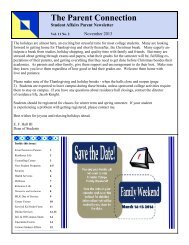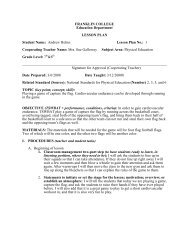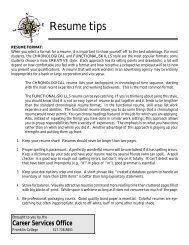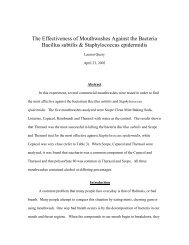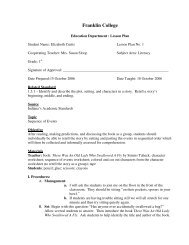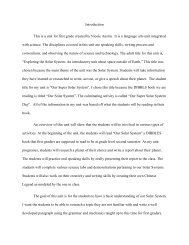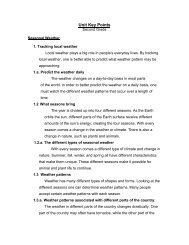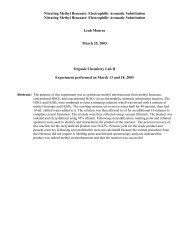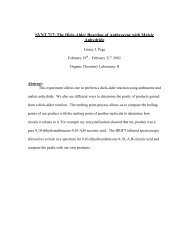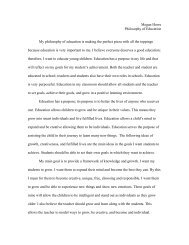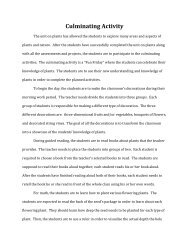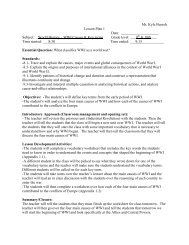Adding/Subtracting Fractions - Franklin College
Adding/Subtracting Fractions - Franklin College
Adding/Subtracting Fractions - Franklin College
You also want an ePaper? Increase the reach of your titles
YUMPU automatically turns print PDFs into web optimized ePapers that Google loves.
FRANKLIN COLLEGE<br />
Education Department<br />
LESSON PLAN<br />
Student Name: Scott Niederhaus Lesson Plan No. 2<br />
Mrs. Habig Subject: Math Grade: 5<br />
Date Prepared: 1/23/07 Date Taught: 1/24/07<br />
Related Standard (Source): Indiana Academic Standards<br />
Math<br />
5.1.6 Describe and identify prime and composite numbers.<br />
5.2.2 Add and subtract fractions (including mixed numbers) with different denominators.<br />
Topic: <strong>Adding</strong> and <strong>Subtracting</strong> <strong>Fractions</strong> (Regrouping)<br />
Objective: The student will be able to add or subtract fractions, while understanding that when a<br />
whole number is crossed out or created it makes a new number while rolling dice to<br />
get the numerator and denominator, along with showing knowledge of common<br />
denominators before adding or subtracting.<br />
Materials:<br />
(Teacher): magnetic numbers (to stick on board for problems), worksheets (for students), and<br />
dice.<br />
(Student): paper, pencil, dice, and worksheet.<br />
I. Procedures<br />
A. Beginning of Lesson<br />
I will have them clap once if they can hear my voice, clap twice if they can hear my<br />
voice, etc. I will start the lesson by having the students help me pick out certain<br />
numbers from the board. I will then tell the students that we will be working on<br />
borrowing and regrouping fractions.<br />
B. Instructional Steps:<br />
1. I will clap once, twice, etc. until the class is ready to listen to what I have to say.<br />
2. Then, I will tell the students we are going to work on regrouping and borrowing<br />
with fractions.
3. I will then call upon a few students to pick designated numbers from the board.<br />
I will have created these numbers and color coded them, so I will ask the student to<br />
pick one pink number, and so on.<br />
4. Once all the numbers have been designated, I will put an addition sign in between<br />
the two fractions we just created.<br />
5. I will then ask the students “In order for us to add the fractions, what do we need<br />
first?” They should say a common denominator.<br />
6. At this point, I will call on another student to come up and select a denominator.<br />
7. I will then ask the students what needs to be done next. They should say add the<br />
fractions together.<br />
8. Once we have added the fractions together, I will ask them what we need to do<br />
next. They should say either add another whole number or add the whole numbers<br />
together.<br />
9. Then, I will ask them what the answer should be. They hopefully will give me the<br />
correct answer.<br />
10. I will then construct a few more addition problems and have students come up to<br />
complete them.<br />
11. I will then switch it over to subtraction, and discuss how we need to borrow if the<br />
first fraction is not as big as the second.<br />
12. I will run through a couple of examples with this, until I feel the students<br />
confidently understand.<br />
13. After this, I will hand out the worksheet I created for the students.<br />
14. After I have handed it out to everyone, I will tell them that they are going to be<br />
paired up with the person sitting next to them.<br />
15. I will then tell them that they are going to receive dice and that one person rolls<br />
one die for the numerator and the other for the denominator.<br />
16. Then, I will tell them they are to repeat this for the next fraction. Then they are<br />
either to add or subtract once they have completed them.<br />
17. I will go through an example with them, so they do not get confused on what they<br />
are supposed to do. Once they are done, I will have them give me their papers and I<br />
will grade them.<br />
Closure Statement: I will recap my lesson with asking what we need to get before we can add or<br />
subtract fractions. Then, I will demonstrate a problem like the students will complete with their<br />
dice.<br />
II. Assessment: I will assess the students on their abilities to get the correct denominator. I will<br />
also assess by watching the individuals at the board borrow, add, subtract, reduce, etc. I will also<br />
assess the students on the papers they turn in.<br />
III. Extension and Remediation: For remediation for a student who struggles with the concept of<br />
regrouping and borrowing fractions, I will take him/her out into the hall or to a table, and we will<br />
work through some problems until he/she understands. If the whole class does not understand, I<br />
will forget the pairs thing, and I will make the problems up on my own. I will then have the
students work them out with me on the board until they understand. For an extension, I will have<br />
a couple of the faster individuals or groups roll the dice and then see who can complete the<br />
problem fastest. If the whole class understands, then we will move on to another subject.<br />
IV. Homework Assignment(s): Worksheet (if not already completed in class)



